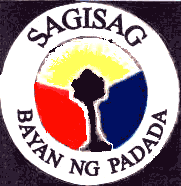|
PADADA
is formed in
physical geography as part
of the province of Davao del Sur lying between
125 degrees 20’ east longitude
and 6 degree 28’ 44’ north latitude. It is bounded on the north
by
the
municipality of Hagonoy, on the west by the municipality of Kiblawan, on the
south by
the
municipalities of Sulop and Malalag and on the east by the
Davao
gulf. The Poblacion is
approximately fourteen (14)
kilometer from Digos, the
capital town of
the province.
LAND AREA
The total land area of the municipality is 4,754 hectares. It has three urban
barangays namely,
NCO, Almendras
and Quirino that totals to one hundred eighty
one hectares. Four of the remaining
fourteen
barangays are located
along the
coastal portion and the other on the internal area.
Two (2%) of the
total
provincial land area is what
constitute the municipality of Padada.
CLIMATE
Hot and humid most of the year. May-November is Typhoon season. The mean annual temperature of the municipality is between 22.4 to 31.5
degrees centigrade.
The
annual rainfall
range from 1,500 to 2,500 mm. The
coldest part of the year is usually during
the month
of December to February
and
the hottest month are April and May. Rainfall distribution
is more or less
even
during the year.
LANGUAGE/DIALECT
English, Pilipino, Chinese, Cebuano is the mother tongue
spoken by 68.82% of the total population.
Other
dialects
spoken in the area are; B´laan, 6.40%; Bagobo 2.88%; Hiligaynon (Ilongo) 1.70%;
Manobo 6.72%;
Ilocano
1.22%
and Tagacaolos 8. 36 %
English and Filipino [formerly spelled Pilipino], which is based on Tagalog, is
the official language.
About 95 percent of the population speaks Visaya. English is widely and commonly
used for educational,
governmental, and commercial purposes.
POPULATION
Population CY 2000 Census: 24,112; Catholics: 17,907.
LOCAL TRANSPORT
Jeepneys and buses are used widely for major routes. Mostly
Tricycles in the poblacion and in neighboring barangays. Bikes are used for
leisure and sporting events.
RELIGION
Majority of the population are Roman Catholics, a few are
Muslims and Protestants.
ELECTRICITY
Nominally 220 Volts 60 Hz. but sometimes lower. Plugs are usually the US style
flat two pin type. Power outage is infrequent.
DRESS CODE
Light, casual clothes are recommended. When visiting churches
or temples, propriety dictates that shorts and scanty clothing be avoided.
ECONOMY
Padada is basically an agricultural area where coconuts abound and to which
copra is the main
produce, maize comes to second as the important crops that is grown including
bananas and
cassava. Other crops include sugarcane, mangoes and papayas. Livestock on farms
include
chickens, goats and hogs.
Marine fishing is an important industry. Barangays along the coastal
portion are
mostly converted
into fishponds that yields bangus [milkfish] and shrimp. The Poblacion serves as the economic
and the business center.
|
 MUNICIPALITY OF PADADA
MUNICIPALITY OF PADADA![]()